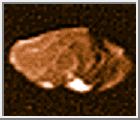 Amalthea
Amalthea
Jupiter V
Amalthea [am-al-THEE-uh] is one of Jupiter's smaller moons. It was named
after the nymph who nursed the infant Jupiter with goats milk.
It was discovered in 1892 by the American astronomer
Edward Emerson Barnard
while making observations from the Lick Observatory with a 36 inch
(91 centimeter) refractory telescope. Amalthea was the last moon in
the solar system to be discovered through direct visual observation.
It was also the first moon of Jupiter to be discovered since
Galileo's discovery of the four
Galilean Moons in 1610.
Amalthea is
extremely irregular, having dimensions of about 270x165x150 kilometers
in diameter. It is heavily scarred by craters, some of which are
extremely large relative to the size of the moon. Pan, the largest crater,
measures 100 kilometers across and is at least 8 kilometers deep.
Another crater, Gaea, measures 80 kilometers
across and is probably twice as deep as Pan.
Amalthea has two known mountains, Mons Lyctas and Mons Ida with
local relief reaching up to 20 kilometers.
The surface is dark and reddish in color apparently caused by a dusting
of sulfur originating from Io's volcanoes. Bright
patches of green appear on the major slopes of Amalthea. The nature
of this color is currently unknown.
Amalthea rotates synchronously
with its long, blunt axis pointed towards Jupiter. Because of
Amalthea's close proximity to Jupiter, it is exposed to the
intense Jovian radiation field. It continuously receives high
doses of energetic ions, protons,
and electrons produced by the Jovian
magnetosphere. In
addition it is bombarded with micrometeorites, and heavy sulfur,
oxygen, and sodium ions that have been striped away from Io.
| Amalthea Statistics
|
|---|
|
|
|---|
| Discovered by | Edward Emerson Barnard
|
|---|
| Date of discovery | 1892
|
|---|
|
|
|---|
| Mass (kg) | 7.17e+18
|
|---|
| Mass (Earth = 1) | 1.1998e-06
|
|---|
| Radius (km) | 135x84x75
|
|---|
| Radius (Earth = 1) | 2.1167e-02
|
|---|
| Mean density (gm/cm^3) | 1.8
|
|---|
|
|
|---|
| Mean distance from Jupiter (km) | 181,300
|
|---|
| Rotational period (days) | 0.498179
|
|---|
| Orbital period (days) | 0.498179
|
|---|
| Mean orbital velocity (km/sec) | 26.47
|
|---|
|
|
|---|
| Orbital eccentricity | 0.003
|
|---|
| Orbital inclination (degrees) | 0.40
|
|---|
|
|
|---|
| Escape velocity (km/sec) | 0.0842
|
|---|
|
|
|---|
| Visual geometric albedo | 0.05
|
|---|
| Magnitude (Vo) | 14.1
|
|---|
 Amalthea
Amalthea
This image of Amalthea was acquired by the Voyager 1 spacecraft on
March 5, 1979.
(Credit: Calvin J. Hamilton)
 Topographic Map of Amalthea
Topographic Map of Amalthea
This is a topographic map of Amalthea. It is based upon the shape model of Phil
Stooke. As with all maps, it is the cartographer's interpretation;
not all features are necessarily certain given the limited data
available. This interpretation stretches the data as far as possible.
(Courtesy A. Tayfun Oner)
 Shaded Relief Map of Amalthea
Shaded Relief Map of Amalthea
This is a shaded relief map of Amalthea, a small satellite
of Jupiter. As with all maps, it is the cartographer's interpretation;
not all features are necessarily certain given the limited data
available. This interpretation stretches the data as far as possible.
(Courtesy Phil Stooke)

 Jupiter
Jupiter
 Adrastea
Adrastea
 Thebe
Thebe

Copyright © 1997 by Calvin J. Hamilton.
All rights reserved.
 Amalthea
Amalthea
 Topographic Map of Amalthea
Topographic Map of Amalthea
 Shaded Relief Map of Amalthea
Shaded Relief Map of Amalthea

 Jupiter
Jupiter Adrastea
Adrastea Thebe
Thebe